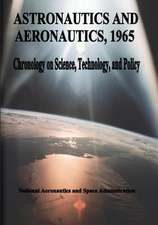Systems Engineering for Commercial Aircraft: A Domain-Specific Adaptation
Autor Scott Jacksonen Limba Engleză Hardback – 28 feb 2015
| Toate formatele și edițiile | Preț | Express |
|---|---|---|
| Paperback (1) | 397.28 lei 6-8 săpt. | |
| CRC Press – 10 mar 2017 | 397.28 lei 6-8 săpt. | |
| Hardback (1) | 557.76 lei 6-8 săpt. | |
| CRC Press – 28 feb 2015 | 557.76 lei 6-8 săpt. |
Preț: 557.76 lei
Preț vechi: 744.01 lei
-25% Nou
Puncte Express: 837
Preț estimativ în valută:
106.73€ • 114.13$ • 88.99£
106.73€ • 114.13$ • 88.99£
Carte tipărită la comandă
Livrare economică 17 aprilie-01 mai
Preluare comenzi: 021 569.72.76
Specificații
ISBN-13: 9781472439215
ISBN-10: 147243921X
Pagini: 314
Ilustrații: Includes 31 b&w illustrations
Dimensiuni: 156 x 234 x 25 mm
Greutate: 0.74 kg
Ediția:2 Rev ed
Editura: CRC Press
Colecția Routledge
ISBN-10: 147243921X
Pagini: 314
Ilustrații: Includes 31 b&w illustrations
Dimensiuni: 156 x 234 x 25 mm
Greutate: 0.74 kg
Ediția:2 Rev ed
Editura: CRC Press
Colecția Routledge
Public țintă
Professional Practice & DevelopmentNotă biografică
Scott Jackson is a lecturer in Systems Architecting and Engineering at the University of Southern California. He is also Principal Engineer for Burnham Systems Consulting, currently working with Embraer in Brazil on systems engineering. Scott received his BS degree in Aeronautical Engineering from the University of Texas in 1957 and an MS degree from UCLA in 1966 in fluid mechanics. He also holds an MA in Liberal Arts from CSU Long Beach. Scott is currently a PhD candidate in systems engineering at the University of South Australia. Since 1965, Scott’s work has been dedicated to systems engineering, culminating in a focus on its application to commercial aircraft at Boeing. He is a Fellow of the International Council on Systems Engineering (INCOSE) and a Boeing Associate Technical Fellow in Systems Engineering. In 2006, Scott was awarded the Distinguished Engineer Award by Orange County Engineering Council.
Recenzii
’In this update Scott Jackson emphasizes and amplifies why systems engineering is critical for engineers and project managers, and how to apply it to developing modern commercial aircraft. His additional emphasis on organizational effects bridges the traditional gaps between engineering and project management and manifests the power of systems engineering to integrate across boundaries among products, services, people, and organizations.’ Ronald S. Carson, Missouri University of Science & Technology, USA and The Boeing Company (retired) ’This book addresses the subject respecting the characteristics of each organization, always showing the advantages of implementing the SE focused on the results. Scott Jackson efficiently and objectively presents how to address the life cycle of the aircraft in a functional vision. He concentrates on the application of the vision of the development of the whole as distinct from the parts and furnishes an objective way to facilitate the understanding of the roles and responsibilities within the organization when using Systems Engineering.’ Wellington M. Oliveira, Systems Engineering - EMBRAER S.A.
Cuprins
List of Figures, List of Tables, Acknowledgments, Acronyms and Abbreviations, Symbols, Preface, 1 Introduction, 2 Commercial Aircraft, 3 Functional Analysis, 4 Requirements and Needs, 5 Constraints and Specialty Requirements, 6 Interfaces, 7 Synthesis, 8 Top-Level Synthesis, 9 Subsystem Synthesis, 10 Certification, Safety, and Software, 11 Verification and Validation, 12 Systems Engineering Management and Control, 13 Adapting Systems Engineering to the Commercial Aircraft Domain, 14 Large-Scale System Integration, 15 Risk Management, 16 Resilience of the Aircraft System, Final Comments, Appendix 1 The Mathematics of Reliability Allocation, Appendix 2 Example Commercial Specification Outline, Appendix 3 Systems Engineering Automated Tools, Bibliography, Glossary, Index
Descriere
Scott Jackson explains the principles of systems engineering in simple, understandable terms and describes to engineers and managers how these principles would be applied to the development of commercial aircraft. More of a how and a why guide rather than a what guide, the book stresses that systems engineering is an integrated technical-managerial process that can be adapted without sacrificing the quality in which risk handling and management is a major part.




























